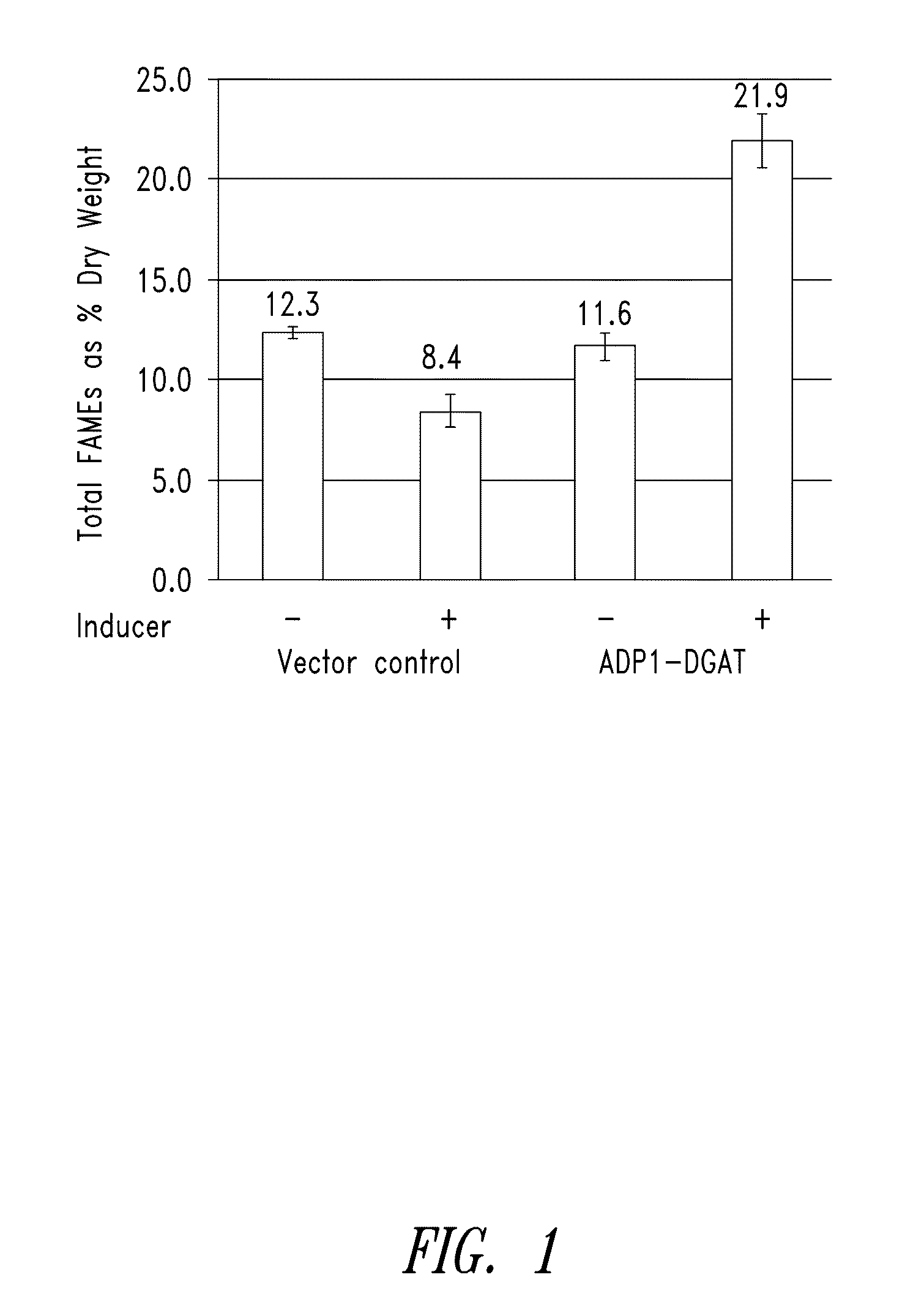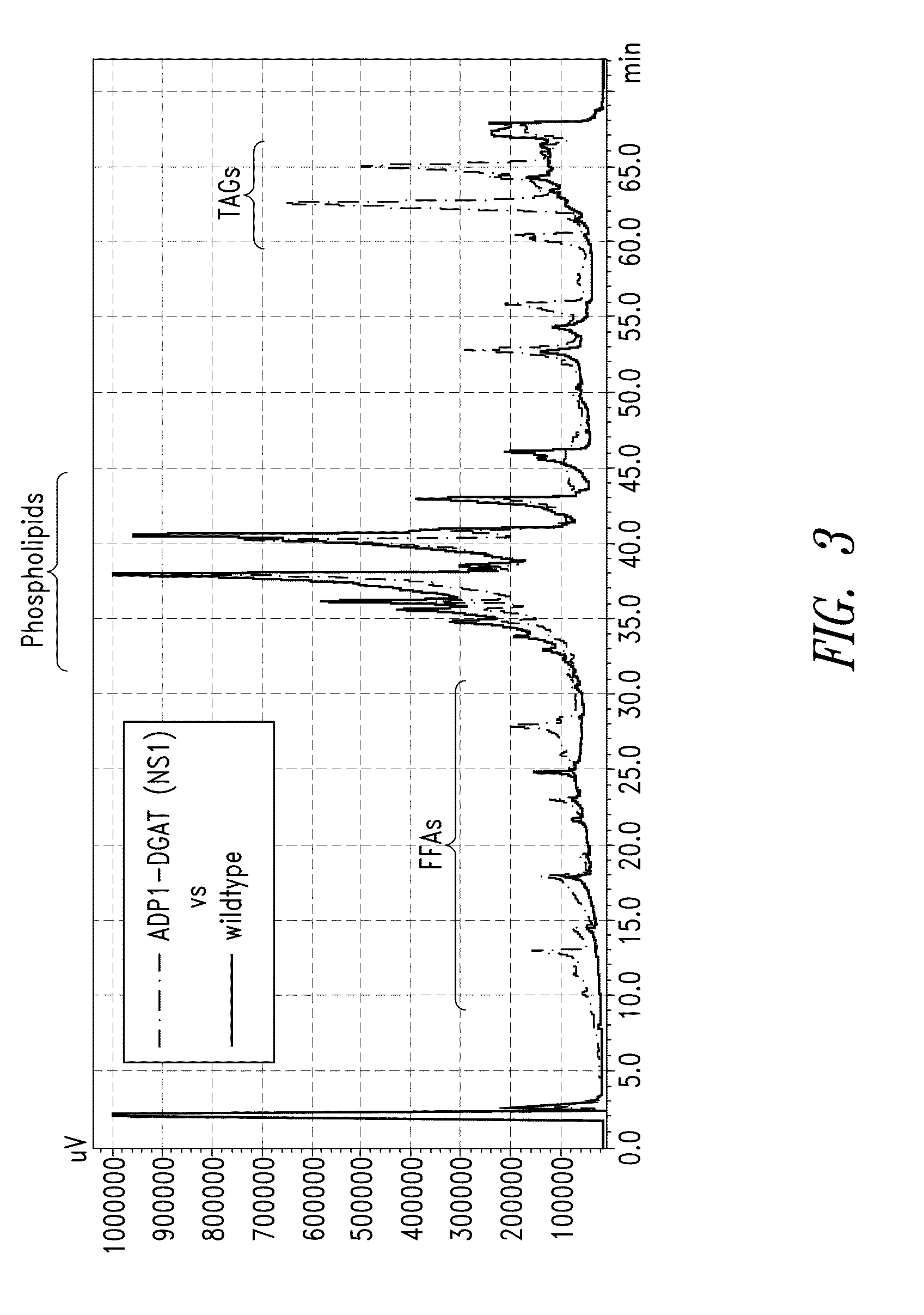Modified photosynthetic microorganisms for producing triglycerides
a technology of triglyceride and microorganisms, which is applied in the field of genetically modified photosynthetic microorganisms, can solve the problems of no triglyceride energy storage molecules, algae cannot be readily genetically modified,
- Summary
- Abstract
- Description
- Claims
- Application Information
AI Technical Summary
Benefits of technology
Problems solved by technology
Method used
Image
Examples
example 1
Generation of DGAT and PAP-Expressing Cyanobacteria
[0226]Acinetobacter baylii sp. ADP1, a gram-negative TAG forming prokaryote, contains a well-characterized DGAT (AtfA, also referred to herein as ADP1-DGAT). The ADP1-DGAT nucleotide sequence was synthesized and codon optimized for Selongatus PCC 7942 expression using DNA2.0, received in a plasmid, subcloned using established molecular biology techniques into the IPTG-inducible vector pAM2991trc (this vector contains sequences encoding the lacl transcriptional repressor, and the pTrc promoter which is repressed by Lacl), and recombined into neutral site 1 (NS1) of S. elongatus PCC 7942. Colonies were selected from BG11-spec / strep plates, restreaked for isolation, and tested by PCR for positive colonies. Inducible transcription of the gene was verified by real-time PCR
[0227]Saccharomyces cerevisiae contains three characterized phosphatidate phosphatases, one of which is a soluble, non-integral membrane protein, Pah1p (YMR165C). Pah1 ...
example 2
Generation of DGAT and ACCase-Expressing Cyanobacteria
[0229]Synechococcus sp. PCC 7002 contains fours genes encoding the four subunits of bacterial acetyl coenzyme A carboxylase (7002 acc). These genes (accA, accB, accC, and accD) were PCR amplified and two synthetic two-gene operons were constructed using splicing by overlap extension PCR techniques. Synthetic operon 1 contains accAD and synthetic operon 2 contains accBC. The two synthetic operons were cloned into vector pTG2087 (pAM2314Ftrc3.) The vector pTG2087 contains regions of homology for recombination into neutral site 1 (NS1) of S. elongatus PCC7942, sequences encoding the lacI transcriptional repressor, and the pTrc promoter which is repressed by Lad. Synthetic 7002 acc operons 1 and 2 were cloned into pTG2087, in two separate sites, under control of the pTrc promoter to generate plasmid pTG2087-7002acc. Clone candidates were sequenced to confirm that there were no PCR-induced mutations in the coding sequence of any of th...
example 3
Increased Fatty Acid Production in Cyanobacteria
[0234]ADP1-DGAT-expressing Cyanobacteria from Example 1 was tested for the ability to produce increased levels of fatty acids. Induction of ADP1-DGAT positive clones was carried out by the addition of 1 mM IPTG when culture reached an OD750=0.2. Samples were taken at 24 hours after induction, and analyzed for lipid content by gas chromatography (GC).
[0235]As seen in FIG. 1, GC results showed a 2-fold increase in lipid content for IPTG-induced DGAT compared to un-induced vector control.
PUM
 Login to View More
Login to View More Abstract
Description
Claims
Application Information
 Login to View More
Login to View More - R&D
- Intellectual Property
- Life Sciences
- Materials
- Tech Scout
- Unparalleled Data Quality
- Higher Quality Content
- 60% Fewer Hallucinations
Browse by: Latest US Patents, China's latest patents, Technical Efficacy Thesaurus, Application Domain, Technology Topic, Popular Technical Reports.
© 2025 PatSnap. All rights reserved.Legal|Privacy policy|Modern Slavery Act Transparency Statement|Sitemap|About US| Contact US: help@patsnap.com



